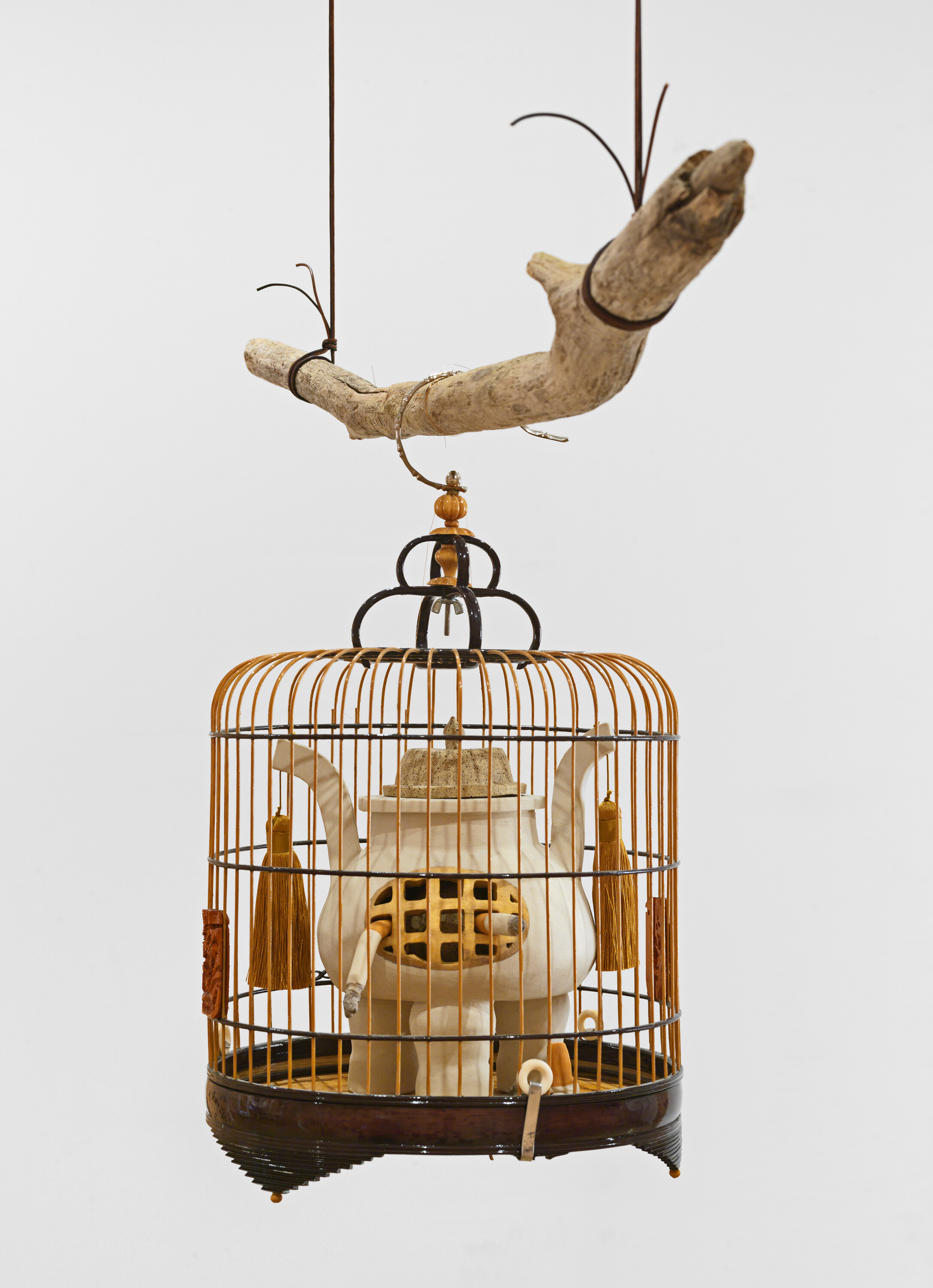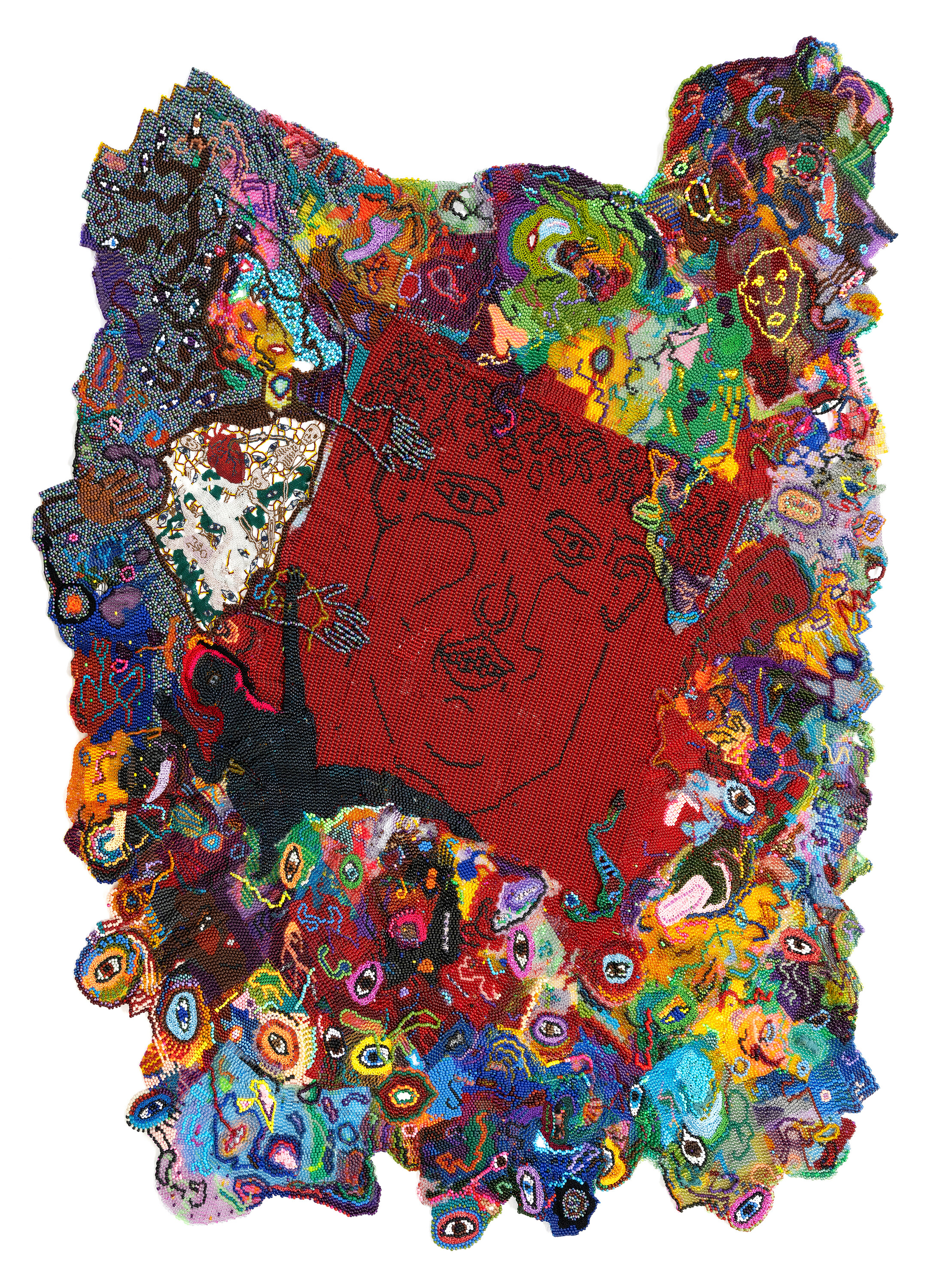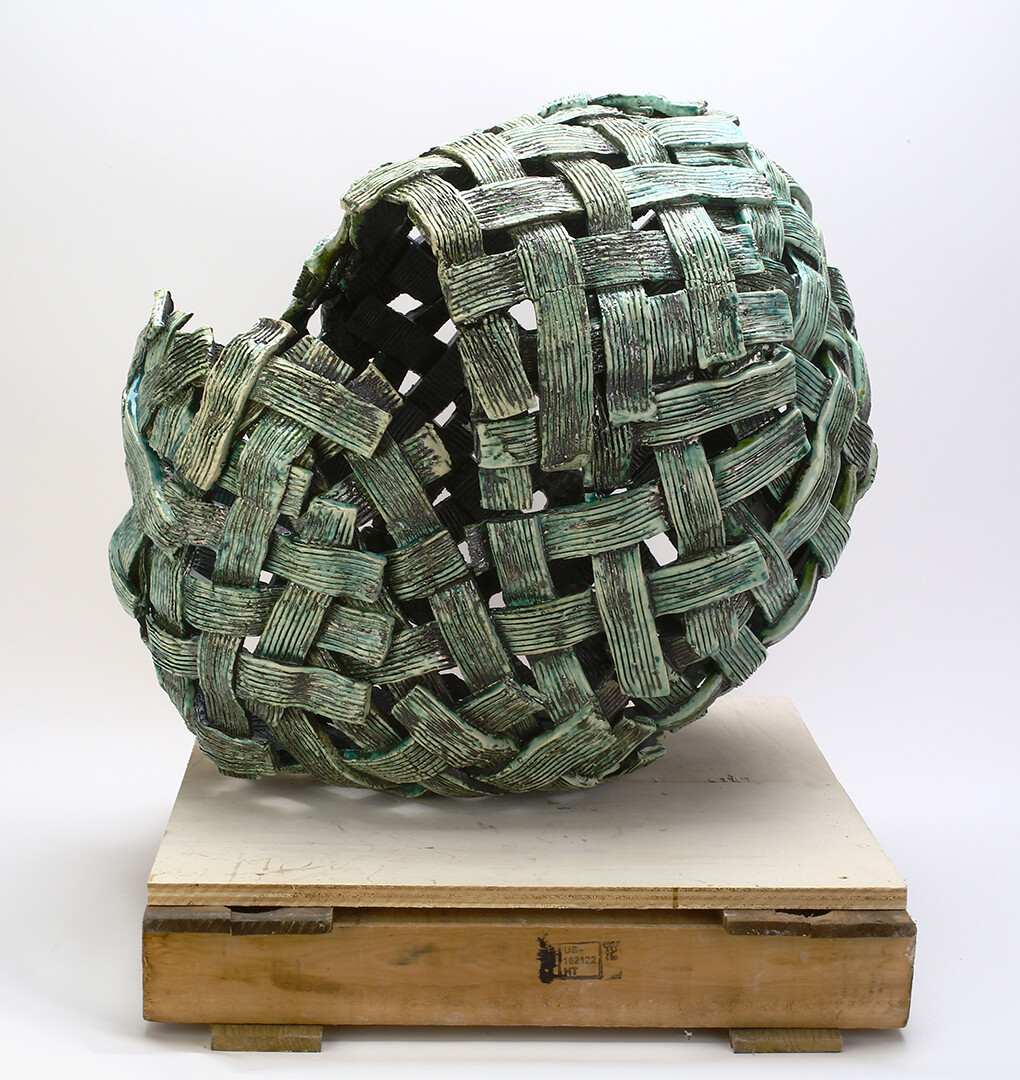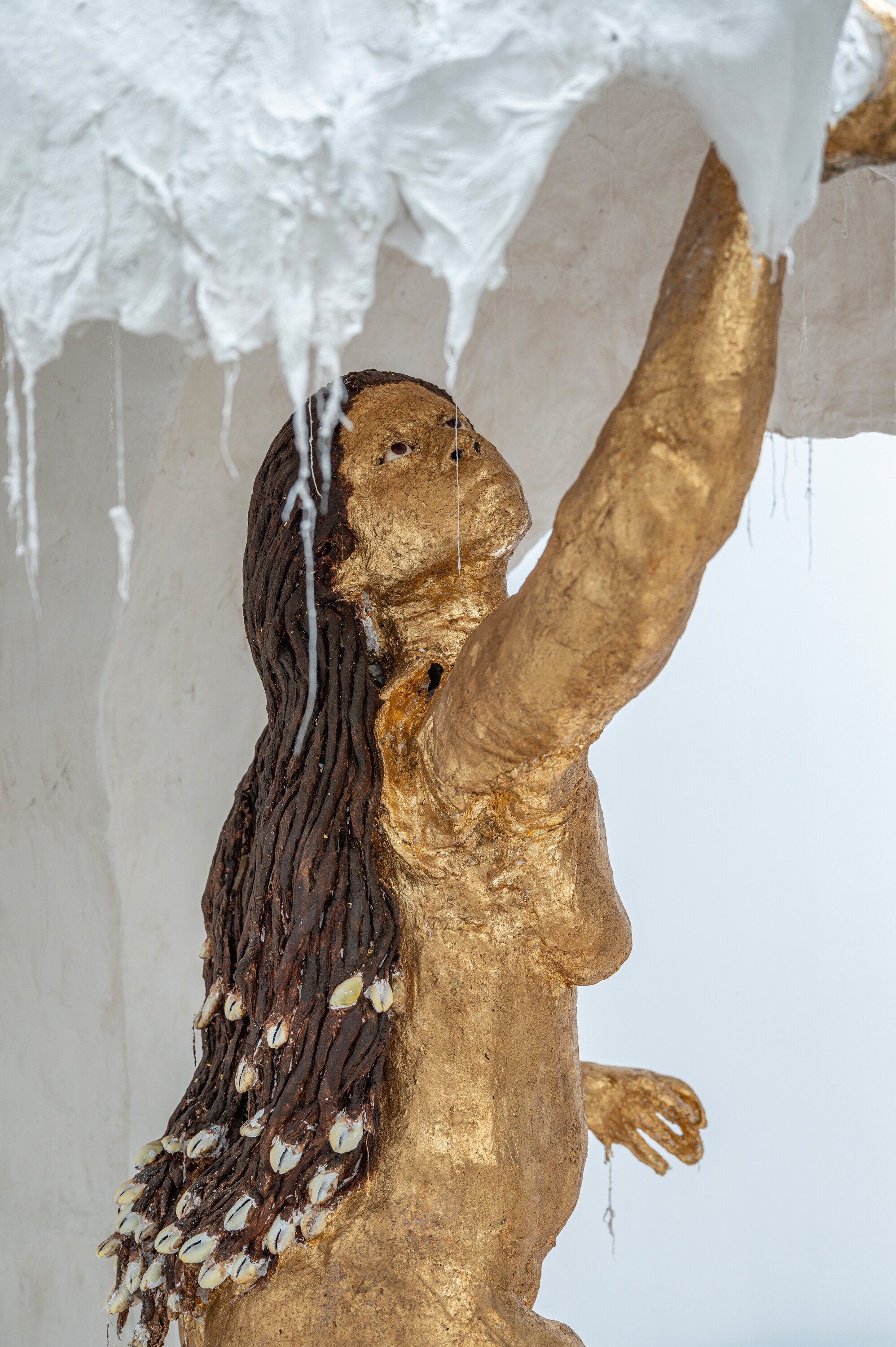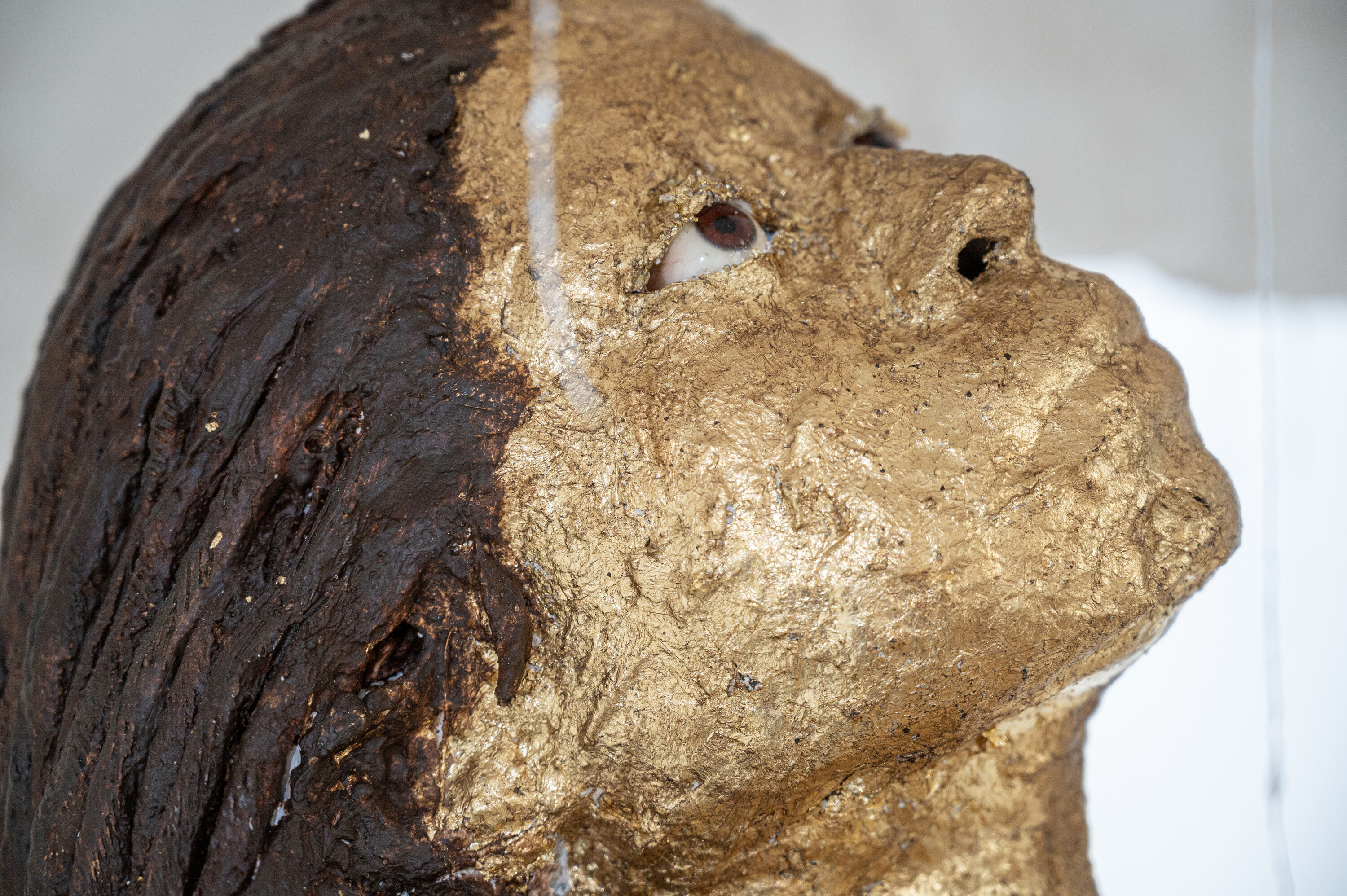
Explore the projects in Platform 2024, Collective Memory, curated by Eugenie Tsai, below.
The large-scale sculptures and installations presented in Platform 2024 consider the intersection of memory, materials, and spirit. The works highlight personal histories put forth by many of the artists, who tapped into their pasts and found generative sparks that shed light on themselves as well as on larger historical and cultural narratives.
Scale is skillfully employed by all of the artists to establish a relationship to the visitor’s body and make a physical impact. The artists are also sensitive to materials, and the way these embody meaning, what we might think of as spirits of the past. Old materials come with the patina of age and use; new materials come with associations as well. Working in combination with imagery and techniques, materials play a significant role in crafting larger personal and cultural stories for visitors to consider.
It is appropriate that these works are sited in the agora, one of the Armory Show’s main arteries. In ancient Greek city-states, the agora was a central public space, a place where citizens came to exchange ideas and engage in dialogue with one other. Platform puts works of art in conversation with one another and with visitors and members of various communities. By drawing on images and ideas from their memories, the artists have made work that embodies their own unique spirit, as well as the spirit of our times.
- Eugenie Tsai
Joana Vasconcelos
Valkyrie Liberty, 2023
Baró Galeria (Palma de Mallorca)
Resembling an inverted enchanted forest or surreal landscape, Joana Vasconcelos’s dramatic hanging structure is pieced together using techniques from her native Portugal, incorporating fabrics from the archive of Christian Dior, LED lights, and hand-made crochet. The work opens a dialogue between the high fashion industry and the domestic realm of artisanal craft, usually reserved for women. The title references a fierce female figure from Norse mythology.
Nicholas Galanin
I think it goes like this (memory and interference), 2024
Peter Blum Gallery (New York)
This bronze sculpture is cast from the pieces remaining after Galanin split imitation totems into firewood-sized sections resembling logs. The imitation totems -- commissioned by Western dealers and carved in Indonesia from tropical wood -- reference the totemic art of numerous Indigenous Pacific Northwest Coastal people without an understanding of cultural knowledge. The bronze logs are welded in place to construct a disorganized figure: a reflection of the decimation of Indigenous culture by colonization. The work acknowledges Indigenous people's effort to rebuild with what remains (material and memory) and the difficulty of this task, due to generations of interference by settlers. An amalgam of material translations, this sculpture is made from a material long associated in the West with monuments and permanence, a concept the artist uses here to insist on the self-determination and self-representation for Indigenous peoples.
Dyani White Hawk, Jim Denomie, & George Morrison
Visiting, 2024; Untitled (Totem Painting), 2016; Totemic Column, 1995 — 2024
Bockley Gallery (Minneapolis)
Bockley Gallery presents a grouping of sculptures by Dyani White Hawk (Sičáŋǧu Lakota), Jim Denomie (Lac Courte Oreille Ojibwe), and George Morrison (Grand Portage Ojibwe) that celebrates mentorship lineages in Native/American modern and contemporary art. Totem (from doodem in Ojibwe, meaning clans and kinship structures) refers to living objects of ancestral, spiritual, and relational significance. White Hawk's beaded column and Denomie’s painted totemic form pay homage to a shared art historical ancestor - a great founding figure of Native/American Modernism, George Morrison. Deeply influenced by Morrison’s carefully honed visual and conceptual languages that embraced surrealist abstraction, including his totemic wooden sculptures, both artists honor the ways he navigated modernism as a Native artist. They also find connection through their shared home of Mni Sóta Makhóčhe and the Great Lakes region.
Sanford Biggers
Mirror, 2024
Marianne Boesky Gallery (New York, Aspen)
Conceptual artist Sanford Biggers presents his largest marble sculpture to date, Mirror (2024), as part of the Chimera series. The series merges elements from traditional African masks, European busts, and classical figures to explore historical representations of the body, along with their myths, archetypes, and power dynamics.
Biggers' method, which he terms "conceptual patchworking," entails transposing, combining, and juxtaposing ideas and forms to challenge historiography, provenance, and official narratives. Through this process, Biggers elegantly balances form, gesture, beauty, and tension. The Chimera sculptures challenge embedded cultural and aesthetic assumptions, acknowledging the complex origins of the forms they reinterpret while envisioning a future ethnography that questions historical narratives.
Dominique Fung
Market Place, 2024
Jeffrey Deitch (New York, Los Angeles)
The sculpture resembles a wooden market stand that is filled with found antique objects from China, including bird and cricket cages, which contain ceramic sculptures made by the artist. Some of these mimic the merchandise offered at fish, meat, and vegetable markets, capturing the spirit of these markets as places for communities to gather and as nurturing sources of sustenance for friends and family, both bodily and spiritually.
The market stand also includes vessels that reference Chinese ceramics, many referencing objects from the Shang dynasty, that embody spiritual as well as historical significance. The artist regards these vessels as representing the art market. Her placement of particular items into vitrines raises the question of who or what determines what objects are given critical, historical, or economic value.
Market Place raises the issue of value and the hierarchies that cultures create around objects.
Joyce J. Scott
Garden Ensconced, 2024
Goya Contemporary Gallery (Baltimore)
This large vibrant tapestry marks a new direction in Scott’s distinguished artistic career. She has long been recognized for her intricately beaded figures which embody the interplay of materials, memory, spirit, and truth-telling. Scott comes from a family of makers who regarded the creation of beautiful, functional objects as a cultural inheritance and a form of resistance to enslavement, sharecropping, migration, and segregation. “Walk a Mile in My Dreams,” her 50-year retrospective, was recently presented by the Baltimore Museum of Art.
Chiffon Thomas
Untitled (Dome, Figure 1), 2023
Michael Kohn Gallery (Los Angeles)
Composed of a life-sized fiberglass cast of a human body lying prone and engulfed by an illuminated geodesic dome of steel and mica, this sculpture’s design was inspired by the futuristic designs of American architect and engineer, Buckminster Fuller, who patented the geodesic dome in the 1950’s. Thomas combines figuration with engineering, foreseeing a machine being or what he refers to as an “impossible body.” At times, he has activated the sculpture with performance, utilizing movement, sound, and lighting to guide collective healing, passage, and regeneration. Thomas’s practice examines the intersection of race, gender expression, and biography. He often draws on his memories of and background in education, percussion, and a childhood steeped in religion. This is the largest of three monumental sculptures the artist produced for his recent solo exhibition at The Aldrich Contemporary Art Museum.
Nari Ward
Dixie Dreamland, 2023
Lehmann Maupin (New York, Seoul, London)
This is a recent example from Ward’s series, which utilizes shoelaces inserted into a wall to render words and phrases. The artist appreciates the familiarity of shoelaces as material. Exploring language’s connection to commemoration, Dixie Dreamland references the 1921 Tulsa Race Massacre, in which armed white residents of the city ravaged Greenwood, Tulsa’s prosperous Black neighborhood known as “America’s Black Wall Street.” Greenwood was home to many thriving businesses including the Dixie Theatre, as well as the Williams Dreamland Theatre, the first cinema for Black people in this segregated city. Located near each other on opposite sides of the street, both theaters were destroyed during the massacre. By rendering their names materially, Ward commemorates these local institutions, acknowledging the rich cultural and economic life of Greenwood, while drawing our attention to the violence of the massacre.
Radcliffe Bailey
The Ocean Between, 2019
Maruani Mercier (Brussels)
Bailey’s life-long practice was an investigation of the African Diaspora, balancing collective cultural memory with familial history. Boats, ships and water are common motifs in his work. They reference ocean crossings such as the Middle Passage of the transatlantic slave trade that changed the course of global history, as well as supernatural crossroads between worlds that exist in the spiritual realm.
Hew Locke
Chariots of the Gods, 2009; Souvenir 12 (Princess Alexandra), 2023; Souvenir 11 (Queen Victoria), 2023
Almine Rech (New York, Paris, Brussels, London, Shanghai, Monaco, Venice, Gstaad)
This work reflects Locke’s visits to London’s Museum of Mankind (now closed), the British Museum’s former repository for non-western art, where he made drawings of objects from this extensive “ethnographic” collection. His piece is composed of treasures from that collection, including the famous Moai figure from Easter Island known as Hoa Hakananai’a, Benin bronzes, Buddhist masks, Inca mummies and Aztec serpents. Locke combined images of these objects into a fantastical heraldic motif. This Coat of Arms mimics those of former colonial countries who adopted this Western mode of identification. Adding another dimension, the title of the work references Erich von Däniken’s 1968 Chariots of the Gods, a book that advances the idea that extra-terrestrial beings are the source of technology for ancient civilizations.
Locke has been fascinated with statues since he was a child in the former British colony of Guyana, where he grew up seeing statues of Queen Victoria. The busts in this series were originally souvenirs of the Crystal Palace to which the artist added jewels, as well as military badges and replica medals. Some of these are from the Benin campaign and the Ugandan and Zulu Wars, and one from the second Afghan War of the late 19th century. Literally and figuratively weighed down by the burden of history these embellished busts highlight the British Empire and the power dynamic between the colonizers, and the colonized.
Anina Major
The Landing, 2024
TERN Gallery (Nassau)
Composed of wooden structures, this installation evokes simple market stalls that can be found in many Caribbean countries. Major fills her stalls with live plants, video, and ceramic vessels of varying sizes. Her distinctive woven ceramics are created using straw plaiting methods passed down to her by her grandmother, who was a straw-market vendor. The artist regards the market as occupying as powerful a place as the beach in the image of Bahamas’s tourist economy. The market is a place where multiple forms of exchange between foreign and local entities take place. The installation refers to different kinds of marketplaces, often near water, ranging from the makeshift to those with more permanent structures. The installation speaks to Major’s migration story of coming from an island and now living in the U.S.
Karon Davis
Sable Venus, 2016—2024
Wilding Cran Gallery (Los Angeles)
Rendered in plaster and created over the course of eight years, Sable Venus depicts the life-size figure of a woman enveloped by a clamshell or the crest of a wave.
Recalling Sandro Botticelli’s Birth of Venus, Davis’s also draws on historical references and theatricality to shed new light on this mythological goddess of love and beauty. Throughout her practice, Davis’s use of plaster reveals her deep interest in the materials of the ancient world, particularly ancient Egypt and its mummification rituals. By using plaster and the process of live casting, Davis seeks to not only capture a fleeting moment in time but to eternalize the spirit and countenance of her models, who are often drawn from her friends and family.

